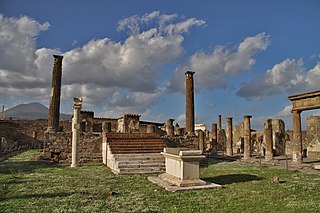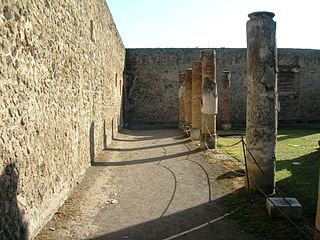Related Research Articles

A Roman villa was typically a farmhouse or country house in the territory of the Roman Republic and the Roman Empire, sometimes reaching extravagant proportions.

Mount Vesuvius is a somma–stratovolcano located on the Gulf of Naples in Campania, Italy, about 9 km (5.6 mi) east of Naples and a short distance from the shore. It is one of several volcanoes forming the Campanian volcanic arc. Vesuvius consists of a large cone partially encircled by the steep rim of a summit caldera, resulting from the collapse of an earlier, much higher structure.

Gaius Plinius Caecilius Secundus, born Gaius Caecilius or Gaius Caecilius Cilo, better known as Pliny the Younger, was a lawyer, author, and magistrate of Ancient Rome. Pliny's uncle, Pliny the Elder, helped raise and educate him.
Ummidia Quadratilla, was a wealthy Roman woman and was a member of the gens Ummidia. She died in the reign of Emperor Trajan (98-117) within a little of eighty years of age, leaving two-thirds of her fortune to her grandson and the other third to her granddaughter. Her grandson Ummidius Quadratus was an intimate friend of Roman Senator and historian Pliny the Younger, who praises her for fostering Quadratus' studies while keeping him untouched by her own luxurious lifestyle.

Pomponianus was a Roman Senator who was present at Stabiae during the eruption of Mount Vesuvius in AD 79. He attempted to escape by ship, but was stuck on shore because the prevailing wind was not favorable.

The Temple of Apollo, also known as the Sanctuary of Apollo, is a Roman temple built in 120 BC and dedicated to the Greek and Roman god Apollo in the ancient Roman town of Pompeii, southern Italy. The sanctuary was a public space influenced by Roman colonists to be dedicated to Greco-Roman religion and culture.

Herculaneum is an ancient Roman town, located in the modern-day comune of Ercolano, Campania, Italy. Herculaneum was buried under volcanic ash and pumice in the eruption of Mount Vesuvius in 79 AD.
Ulpia was a noble Roman woman from the gens Ulpia settled in Spain during the 1st century CE. She was the paternal aunt of the Roman emperor Trajan and the paternal grandmother of the emperor Hadrian.
The gens Ummidia was a Roman family which flourished during the first and second centuries. The first member of the gens to achieve prominence was Gaius Ummidius Durmius Quadratus, governor of Syria during the reigns of Claudius and Nero. The Ummidii held several consulships in the second century, and through the marriage of Gaius Ummidius Quadratus Annianus Verus they were related to the emperor Marcus Aurelius.
On 5 February AD 62, an earthquake of an estimated magnitude of between 5 and 6 and a maximum intensity of IX or X on the Mercalli scale struck the towns of Pompeii and Herculaneum, severely damaging them. The earthquake may have been a precursor to the eruption of Mount Vesuvius in AD 79, which destroyed the same two towns. The contemporary philosopher and dramatist Seneca the Younger wrote an account of the earthquake in the sixth book of his Naturales quaestiones, entitled De Terrae Motu.
Galeria Copiola was an ancient Roman dancer (emboliaria) and actress whom Pliny includes in a list of notable female nonagenarians and centenarians in his Natural History. Because of Pliny's notice, Galeria is one of the few performing artists in classical antiquity whose career milestones can be precisely dated.
Publius Marius P. f. was a Roman senator and ordinary consul in 62 AD with Lucius Afinius Gallus as his colleague. Although Frontinus records that Marius was appointed curator aquarum in 64, we know nothing more about him.

Caius Norbanus Sorex was an actor who lived in Italy and was active at Pompeii and Nemi during the time of Augustus.
The gens Helvia was a plebeian family at ancient Rome. This gens is first mentioned at the time of the Second Punic War, but the only member of the family to hold any curule magistracy under the Republic was Gaius Helvius, praetor in BC 198. Soon afterward, the family slipped into obscurity, from which it was redeemed by the emperor Pertinax, nearly four centuries later.

The gens Norbana was a plebeian family at ancient Rome. Members of this gens are first mentioned toward the beginning of the first century BC, and from then to the end of the second century AD they filled a number of magistracies and other important posts, first in the late Republic, and subsequently under the emperors.
The gens Novellia was an obscure plebeian family at Rome. The only member of this gens known to have held any magistracies was Torquatus Novellius Atticus, perhaps better known from an anecdote of Pliny the Elder; however, many others are known from inscriptions.
Gaius Ummidius Quadratus Sertorius Severus was a Roman senator active during the second century AD. He was suffect consul in absentia for the nundinium of May to June 118 as the colleague of the emperor Hadrian. He is more frequently known by his shorter name, Gaius Ummidius Quadratus; his full name was known only after a missing piece to an inscription from Tomis was found.

Aulus Umbricis Scaurus was a Pompeiian manufacturer-merchant, known for the production of garum and liquamen, a staple of Roman cuisine. He was active in Pompeii between c. 25-35 CE and 79 CE. Scholars believe that A. Umbricius Scaurus was Pompeii's leading fish sauce manufacturer. His products were traded across the Mediterranean in the first century.

Freedmen in ancient Rome existed as a distinct social class (liberti or libertini), with former slaves granted freedom and rights through the legal process of manumission. The Roman practice of slavery utilized slaves for both production and domestic labour, overseen by their wealthy masters. Urban and domestic slaves especially could achieve high levels of education, acting as agents and representatives of their masters' affairs and finances. Within Roman law there was a set of practices for freeing trusted slaves, granting them a limited form of Roman citizenship or Latin rights. These freed slaves were known in Latin as liberti (freedmen), and formed a class set apart from freeborn Romans. While freedmen were barred from some forms of social mobility in Roman society, many achieved high levels of wealth and status. Liberti were an important part of the "most economically active and innovative entrepreneurial class" in the Roman Empire. The legal and social status of freedmen remained a point of cultural and legal contention throughout the Republic and Empire.
Ummidius is a Roman nomen gentilicium. Notable people with the name include:
References
- ↑ James L. Franklin, Jr. 1987. “Pantomimists at Pompeii: Actius Anicetus and His Troupe.” The American Journal of Philology 108.1:95-107.
- ↑ Beard, Mary (2010-07-09). Pompeii: The Life of a Roman Town. Profile Books. pp. 258–. ISBN 9781847650641 . Retrieved 27 November 2014.
- ↑ "Gaius Ummidius Actius Anicetus, pantomime" ILS 5183
- ↑ Robert K. Sherk (14 July 1988). The Roman Empire: Augustus to Hadrian. Cambridge University Press. pp. 212–. ISBN 978-0-521-33887-5.
- ↑ Pliny Epist. 7.24.1
- ↑ Alison E. Cooley; M. G. L. Cooley (1 October 2013). Pompeii and Herculaneum: A Sourcebook. Routledge. pp. 99–. ISBN 978-1-134-62449-2.
- ↑ CIL 4, 5399
- ↑ CIL 4, 4965
- ↑ CIL 4, 10643c
- ↑ Caroline Lawrence (30 December 2010). Trimalchio's Feast and Other Mini-Mysteries. Orion Publishing Group. pp. 75–. ISBN 978-1-84255-757-0.